Text
Premiere of The Heiress

Premiere night of The Heiress at Fox Carthay Circle Theater in 1949. Directed by William Wyler, starring Olivia de Havilland and Montgomery Clift. The movie was nominated for 3 Golden Globes and de Havilland won for Best Actress. Nominated for 8 Academy Awards, it won for Best Actress, Best Art Direction, Best Costume Design, and Best Score.
To view more photographs from our collection of movie premieres, theaters, and more, please visit: https://www.hollywoodphotographs.com/
#historic hollywood photographs#hollywood#movies#Movie Premieres#theaters#oscars#academy award winner#architecture
6 notes
·
View notes
Text
Photo of the Week: The First Academy Awards

It's beginning to look like Awards Season in Hollywood so in the coming weeks, we'll highlight some favorites from our archive, starting with this one, of the first ever Academy Awards banquet in the Blossom Room at The Hollywood Roosevelt in 1929. The Academy of Motion Picture Arts & Sciences was founded in 1927, but the first private dinner and ceremony wasn't held until 1929, hence the caption that reads "Second Anniversary and Awards Banquet".
https://www.hollywoodphotographs.com/
#academy awards#roosevelt hotel#historic hollywood photographs#hollywood#oscar night#oscars#firsts#movies#celebrities
4 notes
·
View notes
Text
Santa Claus Lane, Hollywood CA

Santa Claus Lane Christmas Parade on Hollywood Blvd. (1940)
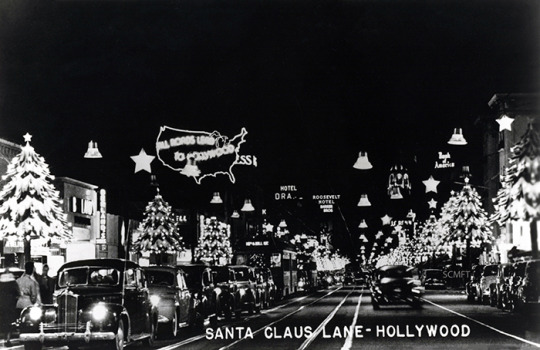
Christmas decorations on Hollywood Blvd. (1940)

Claudette Colbert stands next to her Christmas wreath on Vine St. (1932)

Ornamental Christmas tree street lamp on Hollywood Blvd. (1933)
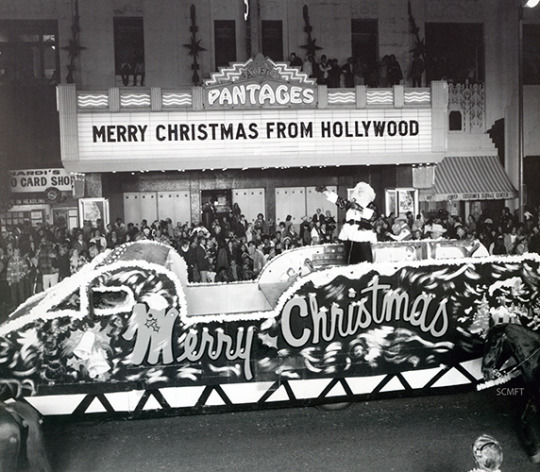
Santa Clause Lane Christmas Parade (1973)
Want to see more historic photographs of Christmases past? Check out our Hollywood Blvd., Vine Street, and Parades galleries or type “Christmas” into our handy search tool to view all the festive images in our Historic Hollywood Photographs collection. Happy Holidays, everyone!
#historic hollywood photographs#santa clause lane#christmas#parades#hollywood#hollywood blvd#celebrities#decorations#vine street#history
0 notes
Text
Everyone Loves A Parade
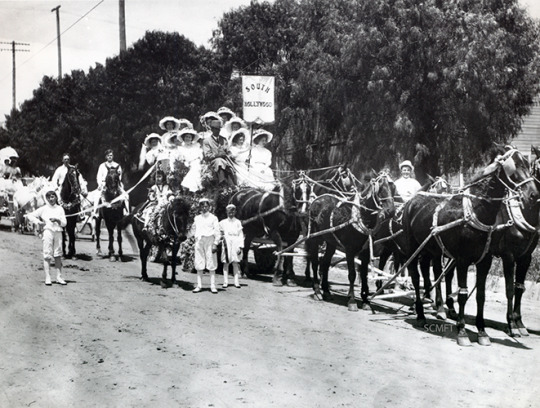
Parades were a popular form of entertainment in early 20th century California, marking the community’s favorite holidays and special events. Hollywood’s first such celebration in 1907 was a smaller version of Pasadena’s now famous Rose Parade, known as the Tilting Tournament and Floral Parade in which early automobiles and wagons, decorated with flowers and banners, traversed the Boulevard between Highland and Cahuenga. There was also an Old Settlers Parade to commemorate the contributions of Hollywood’s pioneer families.

By the late 1920s, Hollywood Boulevard was a nationally famous shopping destination, home to the finest retailers in Southern California, made even more popular by movie star visits. In 1924, the merchants began to decorate their windows; lighted trees and other decorations were added to the sidewalk décor; and lights were strung across the thoroughfare. These property owners “initiated a new Christmas activity (in 1928), which was destined to become one of the outstanding features of the Christmas season”, notes historian Bruce Torrence.
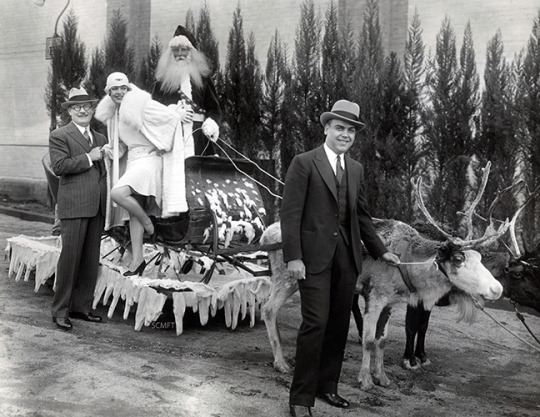
Santa Claus along with various celebrities made their way down the Boulevard in a sleigh pulled by reindeer. Later, the reindeer caught a break as a truck replaced them and the float was motorized. For every decade since, the parade has maintained tradition with sprays of artificial snow, klieg lights, marching bands, cowboys on horseback, stars in convertibles, and floats sponsored by community businesses and organizations. Thousands lined the street to watch. Every year since the 1950s, it has been televised on local television stations, with celebrity hosts giving audiences the play by play, while cameramen risk their safety to deliver up close and personal shots.

Like most everything else in 2020, this Hollywood tradition will take a necessary breather this year. The Hollywood Christmas Parade, originally known as the Santa Claus Lane Parade when it debuted in 1928, will instead be replaced by a television special (“Hollywood Christmas Parade: Greatest Moments” airing on the CW tonight, Friday December 4). The parade, which historically signaled the start of the Christmas shopping season on the Sunday after Thanksgiving, was the brainchild of the Hollywood Merchants Association, the precursor of today’s Hollywood Chamber of Commerce.
Luckily, you can also take a trip down memory lane of Christmases past by visiting our collection of historic parade photographs, which capture all the glitz and glamour of these events from the 1920s-70s. The landmark buildings and marquees of the movie palaces along the boulevard are prominently featured, and the night shots of neon and klieg lights remain spectacular. My particular favorites: intimate portraits of Jayne Mansfield and Ronald Reagan (1959), and Natalie Wood and Robert Wagner as grand marshals in 1979. Any parade that celebrates Lassie is a winner in my book!
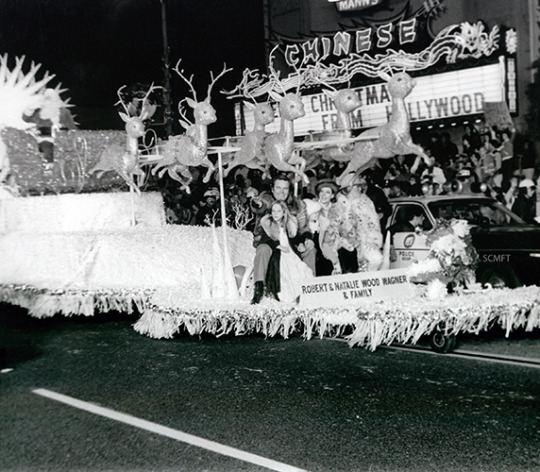
~ Christy McAvoy, Historic Hollywood Photographs
Reference: Hollywood: The First 100 Years, Bruce Torrence, p.112-118.
#historic hollywood photographs#hollywood#hollywood blvd#christmas#parades#holiday#hollywood christmas parade#history#celebrities
0 notes
Text
Photos of the Week: Thanksgiving at the Hollywood Canteen

Spencer Tracy, Bette Davis and Jack La Rue serve turkey at the Hollywood Canteen (1944)

Actor Warren Williams watches Charles Coburn carve a turkey at the Hollywood Canteen (1944)

Dinah Shore with servicemen on Thanksgiving Day at the Hollywood Canteen (1943)

Dane Clark, Robert Hutton, Una O'Connor, and Sidney Greenstreet serve dinner to servicemen at the Hollywood Canteen (1944)
For more images from our Historic Hollywood Photographs collection of the Hollywood Canteen click here.
Happy Thanksgiving!
#historic hollywood photographs#hollywood#hollywood canteen#servicemen#celebrities#thanksgiving#1944#world war ii#holidays
2 notes
·
View notes
Text
Featured Photo Gallery of the Week: Hollywood Canteen

Danny Kaye entertains servicemen at Hollywood Canteen (1943)
Shortly after the outbreak of World War II, actress Bette Davis approached fellow actor John Garfield and Dr. Jules Stein about starting a canteen for servicemen in Hollywood, similar to the Stage Door Canteen in New York. The three approached all the entertainment unions, guilds, movie studios and radio stations for support. They found a dilapidated barn located at 1451 N. Cahuenga Boulevard and leased it for $100 a month for the duration of the war. Hollywood's motion picture craftsmen volunteered their services to do the renovation and transformed the place.

Fay McKenzie dancing the Jitterbug with a serviceman at the Hollywood Canteen (1943)
It was unanimously agreed that the Hollywood Canteen would be exclusively for enlisted servicemen, no officers allowed. The servicemen's uniform was his admission ticket. The only people allowed to volunteer were those who worked in some facet of the entertainment business.
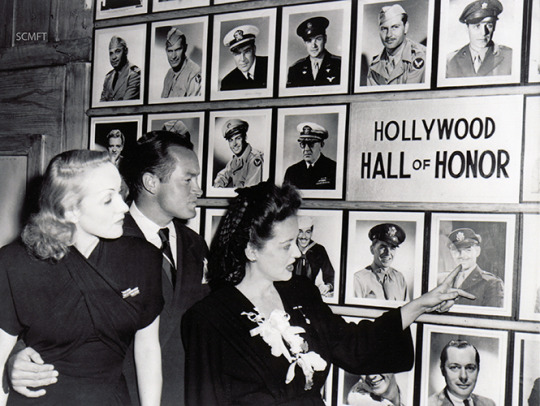
Betty Davis points to the Canteen's Hall of Honor while Bob Hope and Marlene Dietrich look on (1943)
The Canteen had its grand opening on October 3rd, 1942 with Eddie Cantor as MC. The forecourt was filled with thousands of servicemen, dignitaries and civic leaders. All food, beverages, and cigarettes were free. Each night, two bands played to packed dance floors. Entertainers included: Red Skelton, Spencer Tracy, Rosemary Clooney, Bob Hope, Bing Crosby, and many more. Hostesses included: Rita Hayworth, Marlene Dietrich, Paulette Goddard, and Joan Crawford, to name just a few.
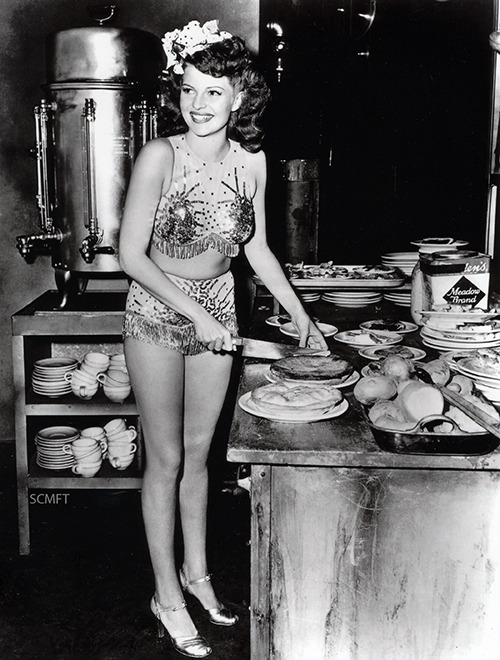
Rita Hayworth cutting pies at the Hollywood Canteen (1943)
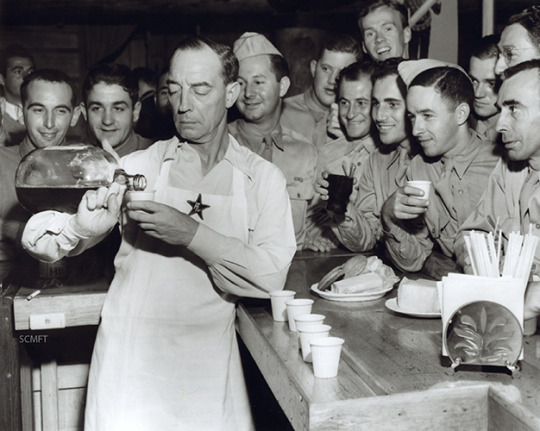
Buster Keaton pours punch at the Hollywood Canteen (1944)
When the war ended in 1945, fewer servicemen visited and the canteen ultimately closed by November. Over the course of its 3 year existence, the Hollywood Canteen had over 3 million servicemen come through its doors. It was truly Hollywood's finest home-front contribution to the war.
On this Veteran’s Day, we welcome you to take a trip inside the canteen by visiting our collection of over 430 images taken in its heyday between 1942-45. You may also enjoy our gallery of VJ Day photographs capturing the big celebrations in the streets, particularly on Hollywood Boulevard, the day the end of the war was announced on August 14, 1945.
~Christy McAvoy, Historic Hollywood Photographs
#historic hollywood photographs#hollywood#hollywood canteen#wwii#world war ii#servicemen#celebrities#veterans#history
14 notes
·
View notes
Text
Photos of the Week: Barkie’s and Sphinx Realty

Woman sips a soda in front of Barkie's Sandwich Shop at 3649 Beverly Boulevard in 1928

Gwen Lee in front to the Sphinx Realty office at 537 N. Fairfax Avenue in 1929
These two photographs are examples of “programmatic” or “mimetic” architecture from our archive. Designed to attract the attention of passing motorists, these humorous buildings were quite popular in Southern California in the 1920s and 30s. For the most part, they were very small structures usually designed to highlight the type of business, particularly local restaurants. Famous landmarks, animals, fruits, vegetables, donuts, hot dogs, and articles of clothing all received this super-sized treatment on the Southland’s thoroughfares.
We’re not quite sure why this realtor chose the Sphinx for his office, other than the fact that Egyptian-themed architecture was very popular in the early 1920s due to discoveries of artifacts and tombs in Egypt. A giant dog is, of course, always an attraction, although the connection to sandwiches is somewhat obscure. Nevertheless, these miscellaneous favorites of mine are fun stand outs from our collection worth highlighting.
~ Christy McAvoy, Historic Hollywood Photographs
#historic hollywood photographs#architecture#barkie's sandwich shop#sphinx realty#history#fairfax avenue#programmatic#hollywood#beverly blvd
0 notes
Text
Hollywood Forever Cemetery
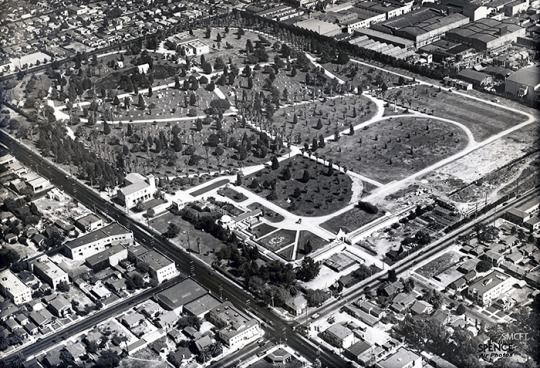
In 1899, F.W. Samuelson purchased 100 acres bounded by Santa Monica Boulevard on the north, Melrose Avenue on the south, Gower Street on the west, and Van Ness Avenue to the east, from the Gower family. The Gower’s holdings stretched from Melrose Avenue to Sunset Boulevard, right in the heart of Hollywood. Samuelson incorporated the Hollywood Cemetery Association and proceeded to lay out the grounds for a memorial park. Entrance gates, an administration building, and a chapel were erected. The first interment took place in 1901. During its first two decades, the cemetery became the final resting place for Hollywood’s pioneer families: Wilcox and Beveridge, Griffith W. Griffith, Cornelius Cole, Charles Toberman, H.J. Whitley, and the Gower family itself.
In 1917, the cemetery sold nearly half of its southern acreage to Peralta Studios, an early motion picture facility. That land that later became the home of Paramount Pictures and RKO Studios. At the same time, development of the northern acreage began in earnest. The first phase of the Cathedral mausoleum was designed and built in 1919 by the prominent Los Angeles architecture firm of Marston and Van Pelt, eventually housing 1400 crypts and making it one of the largest mausoleums in the world at the time. Other elaborate private mausoleums, many designed by other prominent architects, also inhabit the grounds. A particularly notable one being that of William Andrews Clark Jr. and family, designed by Robert D. Farquahar in 1921. The Jewish section of the cemetery, Beth Olam, was created in the southwest portion of the grounds in the 1920s and remains one of the oldest active Jewish cemeteries in California. As the complex developed, manicured grounds were laid out in sections with curvilinear pathways connecting them. Major structures for administration, worship, and burial were located on the periphery. A series of water features in the Garden of Legends and near the Fairbanks Lawn added to the ambience.

Hollywood Forever Cemetery under construction in 1932
Morgan, Walls, and Clements created the current administration building at the northern entrance in 1931. The signature building had multiple uses and is acclaimed for its vast employment of travertine and grand meeting spaces utilized by the Masons and Order of the Eastern Star. “Scores of actors, directors, producers, writers, cinematographers and composers rest within its walls”, says the site’s official walking guide, most notably: Judy Garland, Cecil B DeMille, Douglas Fairbanks Sr. and Jr., Charles Chaplin Jr, Al and Charles Christie, Bebe Daniels, Marian Davies, Janet Gaynor, David Horsley, Jesse Lasky, Barbara LaMarr, Tyrone Power, Fay Wray, and the Talmadge sisters Norma, Natalie and Constance. Other prominent citizens included Los Angeles Times’ owners and publishers Harrison Gray Otis and Harry Chandler. There is also a memorial to Oscar winning Black actress Hattie McDaniel, though she was not allowed to be interred there when she died.
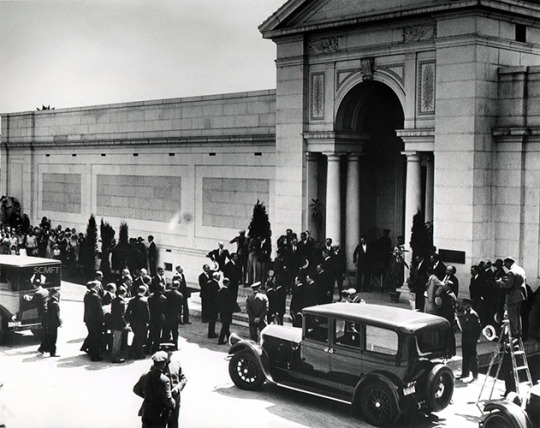
Rudolph Valentino's casket being carried into the Grand Mausoleum
One of Hollywood’s most persistent legends surrounds the death of silent film star Rudolph Valentino in 1926. Valentino’s sudden death triggered a national outpouring of grief from his overwrought fans. After his funeral in New York City, he was interred in crypt 1205 in Hollywood Cemetery’s Grand Mausoleum. Each anniversary of his death was acknowledged in a ceremony and attendees soon began to note the presence of a mysterious “Lady in Black”. Several actresses claimed the title and fabricated versions of their relationship to the star. The tradition and its fantasies continue to this day.
The cemetery became run down by the latter part of the century. There were allegations of mismanagement and the State halted the sale of plots. In 1998, Tyler Cassidy of Forever Enterprises purchased the 60-acre site and began a rehabilitation, changing the name to Hollywood Forever Cemetery. The management introduced new uses with concerts, outdoor movie screenings, Dia de Los Muertos celebrations and more, soon creating a wildly popular new social destination and cultural scene for a new generation of Los Angelinos. An ongoing restoration and development plan ensure the cemetery will be utilized well into the 21st century, and hopefully beyond, as Andy Warhol famously quipped, “The idea is not to live forever, it is to create something that will."
~Christy McAvoy, Historic Hollywood Photographs
Sources: Bruce Torrence archives; E.O. Palmer’s History of Hollywood V. 1; Hollywood Forever Official Walking Guide
#historic hollywood photographs#hollywood#hollywood forever cemetery#movie stars#burial ground#mausoleums#rudolph valentino#cemeteries#Architecture#history#Parks and Recreation
0 notes
Text
Photos of the Week: Hollywood Airfields
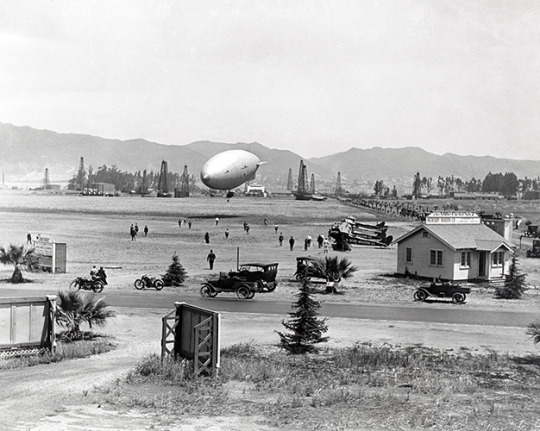
Mercury Aviation at DeMille Field #2 Wilshire Blvd. & Fairfax Ave. in 1921
Recreational flying was all the rage in 1920s Hollywood and airshows were a popular form of entertainment. Cecil B. DeMille, Charlie Chaplin, and other movie luminaries owned planes as well as the airfields where they kept them. This one, at Wilshire and Fairfax, is just about where the new museum of the Academy of Motion Pictures Arts and Sciences is located. The intersection today is a far cry from the open space depicted in this photo, also featuring oil derricks, a blimp, the latest automobiles, and an assortment of planes. I chose it as my Photo of the Week because I love all the different modes of transportation captured in one single shot. The images from our collection that show Hollywood in a way we’ll never see it again, illustrating just how much the city has changed in 100 years, are some of my very favorites.
~ Christy McAvoy

Bathing Beauties at Rogers Field at Wilshire & Fairfax Blvd. in 1921
The Bathing Beauties were a group of pretty, charming, photogenic women originally assembled by film producer, Mack Sennett. Dressed in bathing costumes, they’d appear in early short comedies and the studios’ promotional materials or events to attract extra attention. While there were hundreds about town seeking their big break, most remained nameless. Mabel Normand and Gloria Swanson were two early beauties who would later distance themselves from the moniker, even denying they'd ever been one, once their movie careers took off. Mack Sennett's Bathing Beauties were so popular well into the late 1920s that they inspired imitations at Fox Film Corp. and Christie Studios.
When selecting transportation and airfields as our next themes of focus, this image immediately jumped out as one of those quintessential Hollywood photographs, juxtaposing beautiful women in a typically male, mechanical setting. The airfields gallery on our Historic Hollywood Photographs website contains many such smile-inducing photos with a variety of actors, pilots, crew, even grandmas and pets, posing with planes and mugging for the camera. The aerial landscape shots, with oil derricks and transportation that you just don't see in modern day Hollywood, make it a fun highlight of the collection.
~ Carly Caryn
#historic hollywood photographs#hollywood#los angeles#aviation#wilshire blvd#fairfax ave#transportation#bathing beauty#airfields
0 notes
Text
Photos of the Week: Vern Farquhar’s Hollywood Tire Shop

Vern Farquhar inside his Hollywood Tire Shop on Hollywood Blvd. in 1923
Road trips became a significant part of American life in the 1920s, but the roads were far from hazard free and good tires were essential. Vernon Farquhar made a comfortable living and developed a trusted reputation with his well-regarded tire shop. Originally located at 6262 Hollywood Boulevard, it moved a few years later to 6472 Sunset Boulevard. Farquhar was very active in his community - a founding member of the Lions Club (which provided services to the blind when it formed in 1923), as well as president of the Hollywood Chamber of Commerce.

Vern (kneeling) at his Hollywood Tire Shop on Sunset Blvd. in 1930
I singled out these photos this week because I wanted to give Vern a shoutout in contrast to some the other big Hollywood players we’ve repeatedly highlighted here and he occupied a special place in my own career trajectory having contributed to my graduate thesis with an extensive oral history.
I particularly like this “miscellaneous” photo from our archive of him outside his shop consulting with a couple of water truck drivers as it reminds me of my father, Forrest Robert Tucker, who proudly worked at Sparklett’s Water in Eagle Rock for over 40 years and had a lifelong passion for cars, trucks, and Southern California motor clubs.
~ Christy McAvoy, Historic Hollywood Photographs
#historic hollywood photographs#Vern Farquhar#hollywood#sunset blvd#transportation#hollywood tire shop#history#goodyear#tires#car culture#hollywood blvd
0 notes
Text
Transportation in Early Hollywood: Streetcars and Trains

For the first seventy years of its existence, Hollywood’s growth and development was heavily dependent on its access to rail systems. Its primary industries: real estate, tourism, and the motion picture business simply could not have reached their intended audiences without the elaborate interurban rail system of streetcars and trains developed in Los Angeles in the late 1880s, just about the time that Harvey and Daeida Wilcox were coining the name of their newly acquired ranch “Hollywood”.
The first rail line ran from downtown Los Angeles to a tourist attraction in Griffith Park called Sketchley’s Ostrich Farm. In the late nineteenth century, day trips on the railway were such a popular form of recreation that a second line was soon added: Sherman and Clark’s “Balloon Route” on their Los Angeles Pacific Railroad Company. For $1, one could travel through a variety of landscapes from hillsides to the ocean, including a stop at Paul DeLongpre’s garden estate and gallery in central Hollywood, on its route to and from Santa Monica. Also prominent in the burgeoning tourist industry was the Cahuenga Valley Railroad, which ventured from 2nd Street in Los Angeles to Wilcox Avenue, and later (1914) the “trackless” trolley in Laurel Canyon which accessed the Lookout Mountain Inn.

These sightseeing excursions also served a second purpose: a way to show off the newly platted subdivisions and communities west of Los Angeles. The interurban railway created by Henry Huntington and Sherman and Clark allowed residents to commute to jobs in Los Angeles while enjoying the residential character of coveted enclaves like Hollywood, Beverly Hills, and West Hollywood. Prolific developers such as The Wilcoxes, H.J. Whitley, and the Chandlers, in addition to Sherman and Clark, all promoted signature neighborhoods in this savvy new fashion.
By 1910, the regional rail system was entering its third decade and the moviemakers began to arrive. In their new book Hollywood’s Trains and Trolleys, authors Marc Wanamaker and Josef Lesser explore the intricate connections of the rail system with the burgeoning new industry. “Movement and speed” were particularly key to early film efforts, beginning with Thomas Edison’s The Great Train Robbery (1903). Audiences were instantly entranced both by the technology of transportation and the novelty of moving images, so the two mediums naturally matured together, with motion pictures serving as the perfect vehicle to showcase it all. Images featuring the wonders of California’s weather and varied scenery were quickly transmitted East to entice new residents, the rails were instrumental in transporting emigrants west, and transcontinental lines to New York made the “bicoastal” development of the industry possible. A colorful map in their book pinpoints the location of each studio along the rail lines and Wanamaker’s comprehensive descriptions of studio development additionally illustrate the rise of the industry “from the river to the sea.”

Early films included trains and trolleys as integral characters and developed plots around them. In particular, the genre of Westerns made expert use of the railroad lines, with rail depots (in a variety of architectural styles) pressed into service as sets, and railyards rented by movie studios as locations for filming. Stock was rented from willing owners, and studios acquired their own collections of trains as props, storing them at their “movie ranches” and backlots spread throughout the Los Angeles Basin, making it increasingly easier to incorporate transportation elements into stories. The authors note that “all the motion pictures described and illustrated (in the book) were produced and crafted within a 30 mile radius of Hollywood” and that it was “a lot more economical to build a set in your own backyard than to take a production crew more than 30 miles away.” Hollywood’s Trains and Trolleys succinctly provides a new perspective on the interconnectivity of these two vital pieces of the Hollywood economy, giving readers valuable additional context about how motion pictures were created and distributed.
By the 1960s, the lines had long been removed and many of the ranches sold off for subdivision. Westerns lost favor with audiences and the carefully collected rail cars were sold at auction along with other studio assets of a bygone era. But as this fascinating new resource suggests, the story of Hollywood’s use of trains and trolleys will never be forgotten.
~ Christy McAvoy, Historic Hollywood Photographs
Sources: Bruce Torrence archives; Hollywood’s Trains and Trolleys, Josef Lesser and Marc Wanamaker, Los Angeles Railroad Heritage Foundation, 2019.
#historic hollywood photographs#streetcars#trains#trolleys#transportation#movie studios#urban planning#hollywood#los angeles#history#tourism#interurban railway#movie making
0 notes
Text
Gilmore Field and the Hollywood Stars

Baseball has been a Southern California tradition since the game was created. A favorite image from our Hollywood Photographs collection is the one above featuring a Hollywood team from 1908. A game accessible to all, baseball was not only a part of physical education in schools, but a popular recreational pastime for all ages, with regular sandlot pick-up games and organized leagues at facilities like Wrigley Field and Gilmore Field, throughout the early 20th century.

For almost two decades (1939-57), the familiar cry of “Play ball!” echoed over Gilmore Field, next to the famous Farmers Market in the Fairfax District of Hollywood. Earl Gilmore, oil tycoon and owner of the site, constructed the venue with a seating capacity of almost 13,000. Open air with bleacher seating, the ballpark was a favorite destination for Los Angeles families. Among them was Los Angeles Public Librarian Glen Creason, whose first game ever was a Stars vs. Angels game at Gilmore Field where he fondly remembers, “hot dogs, Coca-Cola, the ever present smell of cigar smoke, vendors selling bottled beer which they would open at your seat, and players like Carlos Bernier.”
Hollywood’s resident team was the Hollywood Stars, so named by Herbert Fleishaker when he moved his Mission Reds team from San Francisco to Southern California in 1938. (Not to be confused with a team of the same name that had shared Wrigley Field with the Los Angeles Angels earlier in the 1920-30s, but later migrated to San Diego). Fleishaker sold the Stars a year later to Robert “Bob” H. Cobb, a Hollywood insider and owner of the Brown Derby restaurant. Cobb enticed other prestigious figures to join him in co-ownership, including George Burns and Gracie Allen, Barbara Stanwyck, Gary Cooper, Cecil B. DeMille, Bing Crosby, and Walt Disney. Each owner viewed the team as a community institution and actively used their cache to publicize it as an extension of their motion picture industry’s events.

Hollywood Stars owner Bob Cobb with two of the team’s players in 1953
The Stars were a very popular and competent team, especially with managers Fred Haney and Bob Bragan at the helm, whose guidance led them to three pennant wins by 1958. Part of the Pacific Coast League, their main rival was the Los Angeles Angels. According to sports historian David Davis, the league was considered “just a notch below the Major Leagues in terms of quality.” The franchises were all well run, and the most talented players often graduated to the majors. The Stars were innovators in the league: televising a home game in 1939, changing their uniform design to improve player efficiency, and being the first to institute the practice of dragging the field mid-game, so as to encourage additional concession sales.

The expansion of the Major Leagues westward caused the dissolution of many PCL franchises. The legendary Dodgers made their move from Brooklyn to Los Angeles in 1958, shifting Stars fan’s attention. (To this day, the Dodgers remain Hollywood’s team and are once again pursuing their dream of a World Series title in 2020’s shortened COVID season).
Despite their winning records, the Stars played their last game at Gilmore Field in front of a crowd of 6,354 spectators in September 1957. Shortly thereafter, the field was razed in 1958 to make way for CBS Television City, an entertainment landmark which still stands on the site between Beverly Boulevard and 3rd Street at Fairfax Avenue.
~ Christy McAvoy, Historic Hollywood Photographs
Sources: Bruce Torrence; David Davis; Glen Creason
#historic hollywood photographs#hollywood#baseball#gilmore field#stadium#farmers market#hollywood stars#team#recreation
1 note
·
View note
Text
The YWCA Hollywood Studio Club: A Place For Women by Women

The Hollywood Studio Club, listed in the National Register of Historic Places and designated Los Angeles Historic-Cultural Monument No. 175, is located at 1215-1233 Lodi Place. It was a chaperoned dormitory, sometimes referred to as a sorority by its residents, and a place for young women involved in the motion picture business to gather. Located in the heart of Hollywood, the Studio Club was operated by the YWCA and housed some 10,000 women during its 59-year existence from 1916 to 1975. It was the home at various times to many Hollywood celebrities, including Marilyn Monroe, Ayn Rand, Donna Reed, Kim Novak, Maureen O'Sullivan, Rita Moreno, Barbara Eden, Dorothy Malone, Marie Windsor, Linda Darnell, Evelyn Keyes, and Sharon Tate.
When the motion picture industry established itself in Hollywood between 1912 and 1920, people came from all over seeking jobs and the demand for housing became increasingly more urgent. Young women aspiring to be actresses like Mary Pickford arrived unchaperoned and in need of safe housing. In 1915, a group of aspiring young women began gathering in the basement of the Hollywood Public Library to read plays. Librarian Eleanor Jones worried about all the young women living in cheap hotels and rooming houses with a lack of supervision and no place to study or practice their craft. To meet that need, the Hollywood Studio Club was born.
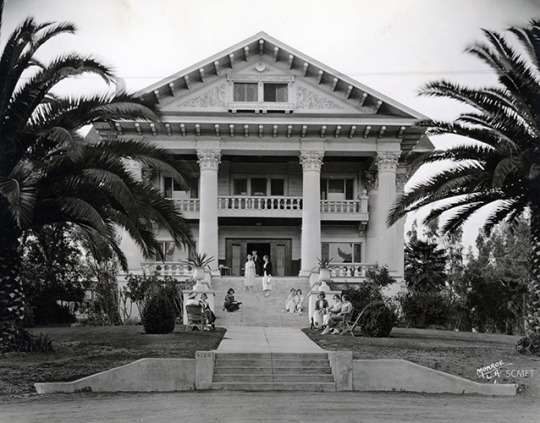
Mrs. Jones solicited help from the local YWCA and a hall was soon established as a meeting place. Hollywood studios and businessmen donated money to rent a house at 6129 Carlos Avenue (pictured above but no longer extant) with space for 20 women. Mrs. Cecil B. DeMille and Mary Pickford were active in the club's operations, and as Pickford recalled, "Mrs. DeMille spent every day doing something for the club. And the motion picture industry supported us."
A newspaper article in 1919 described the Club as: "More of a sorority, with delightful picture 'atmosphere,' than anything else, and the same happy atmosphere will pervade the new home. A dominant note is the refining touch of home life and sense of protection, with assurance of assistance, not only in material way when need arises, but in one's work, as well. Financially, many desperate cases among young women have been tided over by the Hollywood Studio Club."

The only qualification required for acceptance was that applicants had to be pursuing a career in the motion picture business, as an actress, singer, script girl, cutter, writer, designer, dancer or secretary. In addition to providing housing, the Studio Club offered various performing arts classes, and hosted dances, teas, dinners, plays, fashion shows, and stunt nights. The club supplied residents with two meals a day and sewing machines, hair dryers, laundry equipment, typewriters, theater literature, practice rooms, as well as a stage and sun deck.

Between 1923 and 1925, with the need for safe housing growing ever more acute, a widely publicized fundraising campaign was held to build a new facility. Contributions were received from local studios including: Famous Players-Lasky ($10,000), Metro Goldwyn, Carl Laemmle ($5,000 each), Warner Bros. ($3,000), and Christie Comedies ($2,000). In March 1923, aviatrix and movie star Andree Peyre also orchestrated an aerial acrobatic exhibition and airplane race over Hollywood to help raise funds for the new home. In February 1925, a final $5,000 donation from silent screen star Norma Talmadge allowed the group to officially begin construction.
The organization hired acclaimed California architect Julia Morgan, most famous for her design of Hearst Castle for newspaper mogul William Randolph Hearst, to create the new building. Morgan had a long history designing facilities for women throughout California, beginning with structures funded by Hearst’s mother, Phoebe Apperson Hearst. Among her most significant achievements were the Berkeley City Club; Mills College; YWCAs in Pasadena, San Pedro, San Francisco, and Oakland.

She designed the Studio Club as a large Mediterranean style building in three sections, with interiors decorated in "pistachio green, rose coral, and tan." The central section has connecting wings on each side, with its entrance marked by a loggia, three archways with decorative quoins, and a painted frieze above the main entry. The building includes several recurring elements from Morgan's Mediterranean designs: full-length arched windows; balconies with iron balustrades; and decorative brackets. A writer in California Graphic said "this beautiful and spacious new building is but one more jewel in the crown of achieved results which this progressive and cultural little city is wearing so proudly and shows it’s ever increasing desire to give unstinted moral and financial support to every progressive endeavor."
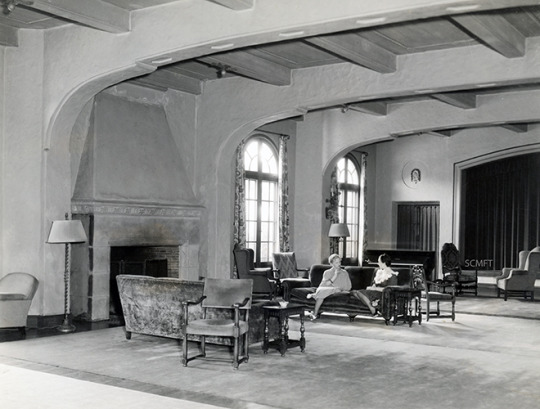
A ground-breaking ceremony took place in June 1925 with Mary Pickford and Julia Morgan in attendance. The new Hollywood Studio Club opened in May 1926 with a ceremony attended by 2,500 people. Built at a cost of $250,000, rooms were named for individuals who made subscriptions of at least $1000 to the building fund. Among those named were Douglas Fairbanks, Howard Hughes, Gloria Swanson, Jackie Coogan, and Harold Lloyd.
In 1946, the club was described this way: "The Hollywood Studio Club has been thought by the unknowing to be a house filled with glamour girls constantly receiving boxes of long-stemmed roses. On the other hand it has been classified as a rescue home for wayward girls. It is neither of these. The club is a comfortable sorority house possessing many of the freedoms and comforts of a man's club. It has grown in 24 years from the home for 22 girls and a white mouse into the home of 100 girls with another 100 servicewomen equally at home in the adjoining guest house”.

By the mid-1960s, times had changed and the idea of a chaperoned dormitory became a dated concept. In 1964, the club expanded its membership to include studio secretaries, dancers, models and others working broadly in the field. Unfortunately, the club was losing money and badly in need of repairs and safety upgrades. The YWCA considered using it for executive offices or selling it, until a petition driven by residents persuaded the organization to keep the facility open. In 1971, the club became a regular hotel for transient women and stopped serving meals.
The Studio Club officially closed its doors in 1975. The building remains under ownership of the YWCA which has always maintained it. Within the last decade, the building served as a YWCA-run Job Corps dormitory and now performs the very important function as bridge housing for homeless women.
Please take a few minutes to enjoy our rare and wonderful gallery of over 100 photographs that capture the two different facilities, the stylish members of the Club engaged in a variety of every day activities, and the special camaraderie shared between these creative, enterprising young women during Hollywood’s own formative years.
~ Christy and Stephen McAvoy, Historic Hollywood Photographs

Sources: Bruce Torrence archives; Hollywood Heritage Newsletter
#historic hollywood photographs#hollywood#history#women#residences#hollywood studio club#ywca#sorority#clubs#julia morgan#Architecture#institutions#National Register of Historic Places#Historic Cultural Monument
0 notes
Text
When Women Build Community

Daeida Wilcox, known as the “mother” of Hollywood, was passionate about making sure her community embraced the arts and education. So at the turn of the twentieth century, she embarked on a series of actions designed to showcase women’s efforts in community building, provide them with educational activities, and place them front and center in the fight for suffrage, alongside an already growing network of women’s organizations across Southern California. To that end, she recruited female residents of Hollywood to create institutions aimed at furnishing its citizens (especially its female members) with outlets for intellectual and creative pursuits. In addition to erecting schools, churches, and a library, Wilcox and her friends spearheaded a burgeoning women’s club movement which became increasingly popular at the turn of the century. Twenty women led by Mrs. James Churchill became founding members of the Woman’s Club of Hollywood in 1905 at a meeting in the home of Mrs. P.B. Chase. The institution actively educated women in classical literature, music, arts, suffrage and other pursuits. Its members also founded the Hollywood Library, Hollywood Bowl, Hollywood Studio Club, Hollywood High School, and Hollywood Hospital.

In 1914, ground was broken for a substantial Neo-Classical clubhouse on Hollywood Boulevard just east of La Brea Avenue. The most famous poet and songwriter of the day, Carrie Jacobs Bond, was on hand to perform her latest composition. The building had classrooms, salons, and a large auditorium. Anchoring the west end of the Boulevard, it was conveniently located near its member’s homes and in close proximity to Hollywood High School (pictured above). Celebrities of the newly created film industry (Chaplin, Pickford, and Fairbanks among them) hosted plays and readings, and used the club for war bond and other fundraising activities. The local newspaper, Holly Leaves, covered their activities weekly, as did the Citizen News.

By World War II, Hollywood Boulevard had become too commercial and noisy to effectively use the facility, so a decision was made to try and find another suitable location for the Woman’s Club. The membership settled on the Hollywood School for Girls property on North La Brea just a few blocks away. The School closed in the mid-1930s and an ad hoc artist colony had since taken up residence on the property. Upon officially acquiring the site in 1945, the Club hired noted architect Arthur E. Harvey to design a new building. Harvey was well known for his significant residential and commercial work, including the Los Altos Apartments, Chateau Elysee, the Wilshire Professional Building, and the American Storage Building. With funding tight, materials still scarce from wartime procurement, and postwar membership needs uncertain, Harvey decided to leave the school buildings standing. He instead designed a simple Spanish Colonial Revival structure on the southern portion of the site with an L-shaped plan which wrapped around the school and hid it from view. An arched arcade entry accessed the main space from La Brea; a secondary entrance was secluded on a porch off the driveway. Harvey created a functional and efficient layout, with a first floor consisting of offices, a large foyer and auditorium with a stage, adjacent salon, kitchen, and restrooms. A library and boardroom were located upstairs. The layout catered to the social and organizational needs of the group, reflecting its mission and function. The configuration of spaces remains unchanged today with no major alterations. Its character-defining materials are simple: brick walls, iron multi-paned casement windows, wood molding, Spanish tile, and wooden floors.

The first meeting in the new clubhouse was held in 1949. The mission of the Club did not change, but rather adapted to the post war conditions, supporting the needs of more working women and children’s charitable causes. Years of dwindling membership took its toll, but eventually the Club rebounded into the twenty-first century, and it continues to educate women, donate to children’s causes, and network with the community to this day. Listed in the National Register of Historic Places and as a Los Angeles Cultural Heritage Monument, the Club is recognized as one of Hollywood’s oldest and most significant institutions.
~ Christy McAvoy, Historic Hollywood Photographs
Sources: Bruce Torrence archives; E.O. Palmer; Woman’s Club of Hollywood website; Los Angeles Conservancy website
#historic hollywood photographs#hollywood#Hollywood Blvd#woman's club of hollywood#women#history#Architecture#community#institutions#national register of historic places#cultural heritage monument
1 note
·
View note
Text
Women and Education in Hollywood
As the nation contemplates the return to school and what form classes might take during the pandemic, I was inspired to reflect on three storied private schools that tell the story of education in Hollywood over a century ago. Two of them heavily incorporated outdoor learning and were centered on properties with imposing residences in which their founders resided. The Misses Janes School and the Hollywood School for Girls are an almost forgotten part of Hollywood history, while Immaculate Heart lives on, still educating women of the community for over a century.
Education was always a priority in Hollywood. Public schools in the Cahuenga Valley date back to the late nineteenth century, with a system of public schools well in place by 1900. The earliest private schools were founded by women and followed avant-garde methods of teaching well beyond formal classroom lectures and recitation. These three institutions each had idyllic settings, sophisticated curricula, and were considered among the finest of the era.

IMMACULATE HEART HIGH SCHOOL AND COLLEGE
In April 1905, the Sisters of Immaculate Heart of Mary broke ground on a hillside covered in mustard flowers at the northwest corner of Western and Franklin Avenues once owned by Colonel Griffith J. Griffith. They built a novitiate and high school for girls, later expanding the range of education to include college level classes. The three-story Mission style building included classrooms, a dormitory, and living quarters for administration. Capped with a red tiled roof, the structure had prominent arched porticos and gleaming gold crosses. The school became an immediate success, drawing students from all over Southern California as well as a few foreign countries. In 1906, it graduated six students from an enrollment of 75. By 1908, the school became the first private school in Southern California to receive college accreditation.
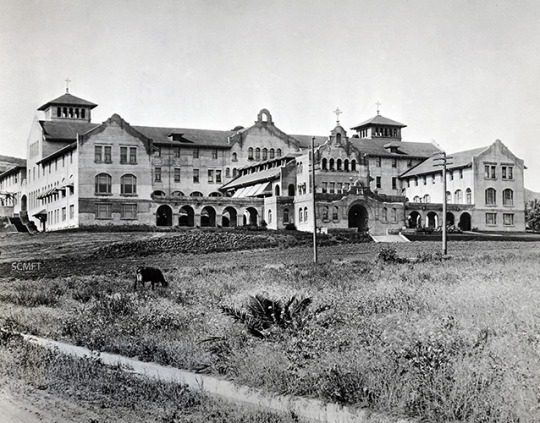
Since its founding, the school has graduated more than 5000 students and has not strayed from its mission of women’s education. The religious order went through turbulent times in the 1960s, emerging as a nonprofit voluntary lay community. One of the members who made the transition was internationally renowned artist Corita Kent (1918-86), a fierce advocate for social justice. Her family moved to Hollywood when she was five. She entered the order in 1936 and eventually became Head of the college’s art department.
Over the years, the campus has changed, but its bucolic setting on the hill continues to play a vital role in education. The original building was replaced in 1973 after the Sylmar earthquake made it vulnerable. A new classroom and library space became the central focus of the high school, while the American Film Institute took over the College Student Union building in 1983.
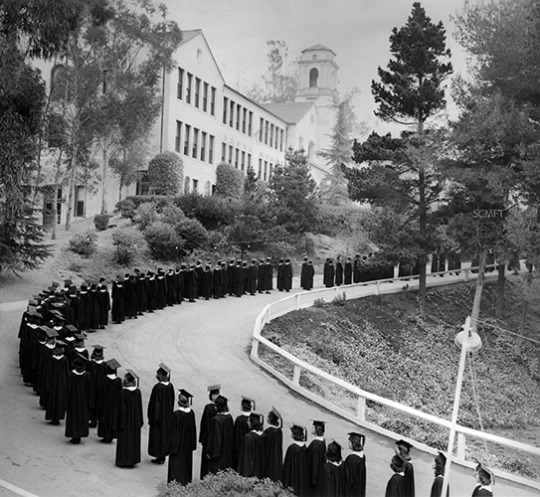
HOLLYWOOD SCHOOL FOR GIRLS
Founded in 1909, the Hollywood School for Girls was located at the western end of central Hollywood at 1749 La Brea Avenue. On the property stood a two story American Foursquare residence constructed in 1903 for Charles Hanchett’s family. Hanchett leased the property to Sophie Shepherd Hogan, who founded the Hollywood School for Girls “for the purpose of associating physical development with grade-school work,” according to historian EO Palmer. By 1912, Louise Knappen, a teacher from Wisconsin led the school. Knappen expanded the curriculum to K-12, emphasizing art and college preparatory courses.
The ground floor of the residence was utilized as a large classroom, while the headmistress occupied a spacious apartment upstairs. In the beginning, all staff lived on site. Scattered about the large wooded property were other classroom structures, several of which were used for art activities and theatre. Advertised as an “outdoor school”, it was celebrated for its lush grounds with trees, winding pathways, and gardens. Known for its quality curriculum, it achieved high academic standing for its college preparatory work, with classes from kindergarten through high school in topics such as Latin, English, French, mathematics, domestic science, art, music and sports. During its peak, it registered upwards of 225 students, mostly female with a smattering of male pupils, with arts and drama its primary emphasis. Edith Head, who later became one of Paramount studios most important costume designers, taught French. Among the student body were Agnes and Catherine DeMille, Catherine Toberman, Dorothy Sills, and a young blonde named Harlean Carpenter, who would later change her name to Jean Harlow as she rocketed to stardom (pictured second from the top left below). Other students who made their way into the industry included Carol Lombard and Joel McCrea, as well as members of the Selznick, Fairbanks, and Goetz families.
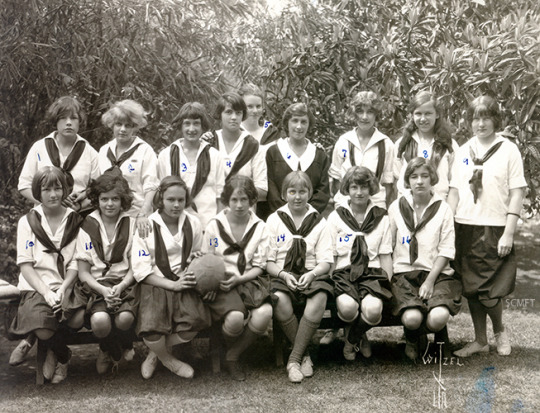
The Depression hurt the school as more options for education became available and the wealthier population of the film industry moved west to Beverly Hills, Brentwood, and Pacific Palisades. The site became an artists’ enclave until it was purchased by the Woman’s Club of Hollywood in 1945. The main residence and two classrooms remain on the northeastern portion of the site today and are listed in the National Register of Historic Places. The rest of the site is occupied by the Woman’s Club of Hollywood.
MISSES JANES SCHOOL

In 1902, Herman Janes moved his wife Mary and their four children (Grace, Mabel, Carrie, and Donald) to Hollywood and into a simple Queen Anne Victorian. Built by developer HJ Whitley, and designed by architects Dennis and Farwell, the home was not as grand as some of its other neighbors on Prospect Boulevard (as Hollywood Boulevard was then known), but it had a prime location in the center of the newly incorporated city and a large front yard. In 1911, the Janes sisters, with the support of their mother, decided to open a school. The Misses Janes School began with 15 students and educated over 2000 until it closed in 1926. It attracted the sons and daughters of the DeMille, Lasky, Ince, Laemmle, and Beery families working in the newly minted entertainment industry and was recognized as historian EO Palmer put it, “by discerning parents of Hollywood as primarily an outstanding character building factor in a child’s life”. Classes were held outdoors and on the spacious porch of the residence.
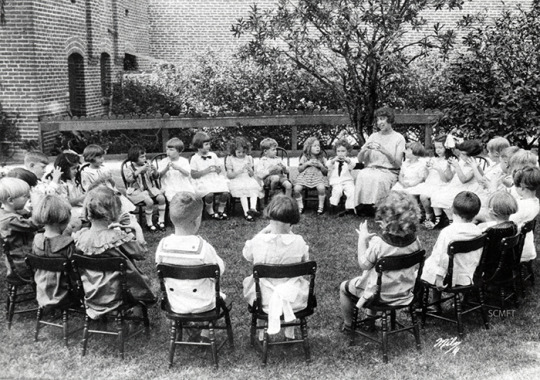
As the Boulevard grew progressively more commercial in the late 1920s, the sisters closed the school, and the playground was soon replaced by a gas station. The sisters continued to occupy the residence until Carrie’s death in 1983. The house played a pivotal role in early historic preservation efforts: purchased and utilized for commercial use, a shopping arcade was added to create additional retail space. Now a nightclub, it is listed in the National Register of Historic Places and as a Los Angeles Cultural Heritage Monument. The Janes House continues to retain its original exterior and interior features and spaces, although its street presence has been diminished. It is one of only two remaining residences in the vicinity that dates from the initial period of Hollywood’s development.
~ Christy McAvoy, Historic Hollywood Photographs
Sources: Bruce Torrence archives; E.O. Palmer’s History of Hollywood Volume 1; The LA Times; Immaculate Heart Center website; Woman’s Club of Hollywood website.
#historic hollywood photographs#hollywood#Hollywood Blvd#schools#women#girls#education#college#history#Architecture
0 notes
Text
Outdoors in Hollywood: BARNSDALL ART PARK
1919 was a watershed year in Hollywood history. World War I had ended. The motion picture industry had put down roots. Hollywood had been a part of the City of Los Angeles for almost a decade. In the Cahuenga Pass, an outdoor cultural venue for music (Hollywood Bowl) was being planned in the Daisy Dell and a second outdoor amphitheater (Pilgrimage Play Theater) was being envisioned in Weid Canyon thanks to the largesse of Christine Wetherill Stevenson, an heiress from Philadelphia. In Vermont Canyon, Griffith J. Griffith was envisioning and endowing a Greek Theater and Observatory in the park he’d donated to the city in 1896 (projects which would not be realized until long after his death in 1919).
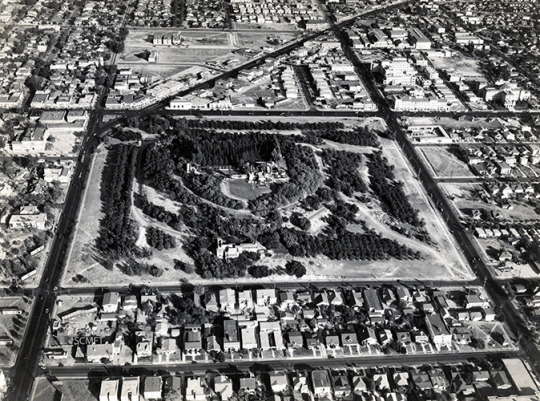
Coincidentally, another Pennsylvania heiress would soon complete the circle of hillside arts venues which stretched from Vermont Avenue to the Cahuenga Pass. It’s a story fit for Hollywood screenplays, starring the era’s most famous architect and an unconventional, dramatic, free-spirited heiress.
The fortunes of Pennsylvania oil baron William Barnsdall and his son, Theodore Newton, financed the artistic ambitions of Newton’s daughter, Aline. Well-travelled and unconventional, Aline possessed a passion for the arts. Her interest in experimental theater led her to Chicago, where she met the equally unconventional architect Frank Lloyd Wright who’d just finished his Midway Gardens project. Barnsdall envisioned her own arts complex years before she found her perfect site in Hollywood. Chicago, Seattle, and San Francisco had also been contenders. She finally decided that Los Angeles would be the ideal location for the ambitious and innovative development, so in 1919 she purchased a Hollywood hilltop known as Olive Hill, on the east end of Hollywood. The thirty-six-acre site had panoramic views of the Cahuenga Valley, the Hollywood Hills and downtown. Wright had already been doing conceptual designs as early as 1915 and took full advantage of this prominent canvas, designing a series of structures and terraces staggered on the hillside.

The residence for Ms. Barnsdall claimed priority. Aline had a daughter in 1917 and desired a home as she contemplated an even larger business venture. Known as Hollyhock House because its abstract design motif incorporated her favorite flower, the house was Wright’s first Los Angeles commission. Built between 1919 and 1921, it represents his earliest efforts to develop a regionally appropriate style of architecture in Southern California that integrated the use of indigenous materials. Taking advantage of the mild climate, the residence is incorporated into its landscape with many of its rooms opening into its garden setting. Said Barnsdall, “Mr. Wright believes that a California house should be half house and half gardens, and I am strongly of the same opinion. I therefore require much room for my own home, but I propose to keep my garden always open to the public, that this spot may be available to those lovers of the beautiful who wish to come here to view sunsets, dawn on the mountains and other spectacles of nature, visible in few other places in the City.”
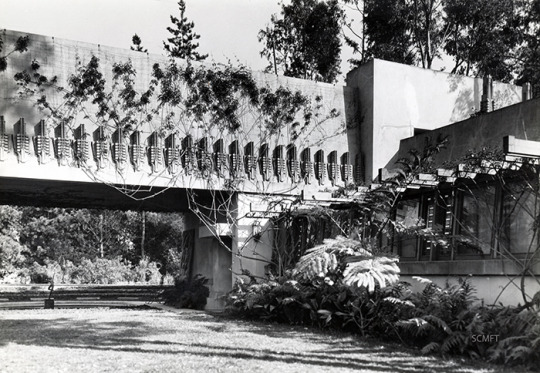
Like many of Wright’s commissions, the relationship between client and architect proved difficult. Both travelled extensively throughout the project, money was tight, and the construction and sequencing changed often with Aline’s disparate visions. A Master Plan for Olive Hill was developed in 1920 and repeatedly revised. A theater, main residence, several ancillary residences, terraced shops and apartments were all contemplated. By 1923, Hollyhock, Residence A, and the now demolished Residence B, along with gardens and landscape features crowned the hilltop. Barnsdall, however, never seemed entirely comfortable or committed to the project and within a year, began to explore the idea of donating it to the City. By 1927, with just a few of the planned structures built, Barnsdall gave Hollyhock House and eleven of the surrounding acres to the City of Los Angeles for use as a public park. The amazing collaboration, which also played a significant role in the careers of Wright’s son Lloyd, and modernist architect Rudolf Schindler, came to an end.
The city later added a Junior Arts Center (1961) and Municipal Arts Gallery (1971), and restored the house, Residence A, and other features. Today, the Barnsdall Park complex is listed in the National Register of Historic Places and is also a World Heritage site. With its mission to present and develop arts in the region, the City continues to restore Wright’s structures with great care.
~ Christy McAvoy, Historic Hollywood Photographs
Sources: Bruce Torrence; EO Palmer; Discover Hollywood magazine; laparks.org; Kathryn Smith’s Frank Lloyd Wright, Hollyhock House and Olive Hill, Rizzoli, 1992.
#historic hollywood photographs#barnsdall park#arts venue#hollyhock house#Hollywood Blvd#frank lloyd wright#Architecture#Parks and Recreation#National Register of Historic Places#history
0 notes
Text
Outdoors in Hollywood: GRIFFITH PARK and One Man’s Vision for Public Recreation

Hollywood’s largest and most spectacular outdoor space is Griffith Park, a gift to Los Angeles by Colonel Griffith Jenkins Griffith. Griffith, a colorful philanthropist, purchased the Los Feliz Rancho and later donated it to the City in 1896. He intended that the 3000+ acres would be used in perpetuity as “a place of recreation and rest for the masses, a resort for the rank and file, for the plain people” including art and educational activities. He left a trust fund for the construction of a scientific observatory and a “Greek” theater in his will. The classically designed cultural institutions were to take advantage of their natural settings within the park, with a theater tucked away in wooded Vermont Canyon and an Observatory atop Mount Hollywood. Today, additional cultural and recreation facilities within the landmark historic district include the Los Angeles Zoo, Travel Town and related railroad museums, the Autry Museum, a carousel (1937), golf courses, hiking trails, and an equestrian center.

GREEK THEATER
2700 Vermont Avenue
The dream for the Greek Theater was slow to fruition, but by 1928 the building had been designed by a consortium of architects, including Samuel Tilden Norton, to resemble a Greek Temple, with its seating designed into the curve of the amphitheater. It opened in 1930, showcasing operatic music for its first few seasons, before broadening its programming to include most all musical genres and theatrical arts. With seating for nearly 4,000 patrons, seats in the lower sections were originally $1, others were free. Like its neighbor in the Cahuenga Pass, the Pilgrimage Theater, it was briefly used as a barracks during World War II, before touring Broadway shows such as Showboat and Anything Goesreturned for its summer seasons during the 1950s and 60s. Intimate concerts with Harry Belafonte, Frank Sinatra, Neil Diamond, Aretha Franklin, Bruce Springsteen, and Santana drew Los Angeles residents for picnics and music year after year. The venue was also used for high school graduations, community events, and location filming. It was expanded to 5900 seats during its 75th anniversary season in 2006, with additional structural refurbishments that were completed in 2015.

GRIFFITH OBSERVATORY
2800 E. Observatory Road
Griffith Observatory's unique architecture and setting, compelling programmatic offerings and cinematic exposure have made it one of the most famous and visited landmarks in Southern California. Tens of millions of people come to tour the building, view the live planetarium shows, or simply gaze out towards the coast and the heavens. This cultural and scientific icon owes its existence to the dream of Griffith J. Griffith, as well as the dedicated scientists and public servants who worked to fulfill his vision of making astronomy and observation accessible to all.
Supplementing his earlier gift of parkland, Griffith offered the City of Los Angeles $100,000 on December 12, 1912 to finance an observatory to be built on the top of Mount Hollywood. Griffith's plan included an astronomical telescope open to free viewing; a Hall of Science designed to expose the public to fascinating exhibits about the physical sciences; and a motion picture theater to show films about science and other educational subjects. This last aspect of the plan would eventually evolve into the planetarium, a technology not invented until the 1920s. Griffith understood that his vision of a public observatory would not be realized in his lifetime, thus he drafted a will containing bequests for the Observatory and Greek Theater, along with detailed specifications regarding the nature of the observatory, its location, and programmatic offerings before his death in 1919.
Master architects John C. Austin and Frederick M. Ashley were responsible for the elaborate Art Deco design which also integrated Classical and Beaux Arts elements. Groundbreaking for the Griffith Observatory occurred on June 20, 1933 with scientist Russell W. Porter and Caltech physicist Edward Kurth being instrumental to the process. The Long Beach Earthquake of 1933 led the design team to make changes to strengthen walls and forego the use of terra cotta on the exterior, though the lower construction cost of the Great Depression still allowed for the use of high-quality materials and finishes (colorful tile, sophisticated metal workings, and marble) throughout the interior. Six artists created sculptures for the site funded by a public works initiative including the Astronomers Monument, thought to be one of the most significant pieces created by the program.

The dedication and formal opening of the Griffith Observatory took place amid much fanfare on May 14, 1935. The Griffith Trust transferred ownership of the building to the City of Los Angeles’s Department of Recreation and Parks, which has operated the facility ever since. Intended mainly for nighttime viewing of the Moon and solar system, it’s been a continuously popular destination since its opening, with more than 10 million people putting an eye to the Observatory's original 12-inch Zeiss refracting telescope. More people viewed Halley's Comet, and the Hale-Bopp and Hyakutake comets, through the Observatory's Zeiss telescope than any other telescope on the planet. The Griffith Observatory has also been a location site in many Hollywood movies, including most famously, Rebel Without A Cause starring James Dean and Natalie Wood. For years, the observatory has been flooded with searchlights at night, and from its perch high atop Mount Hollywood, one can see the Hollywood Sign, The Ennis House and Barnsdall Art Park designed by Frank Lloyd Wright, and numerous other landmarks throughout Hollywood’s basin.
~ Christy McAvoy, Historic Hollywood Photographs
Sources: Bruce Torrence; EO Palmer; Discover Hollywood magazine; lagreektheater.com; laparks.org/griffith; A History of the Griffith Observatory, Hansen, Wang and Cook.
#historic hollywood photographs#hollywood#los feliz#griffith park#greek theater#observatory#parks and recreation#amphitheaters#telescope#history#architecture
1 note
·
View note